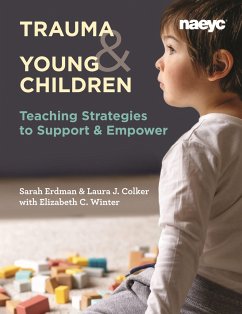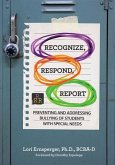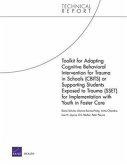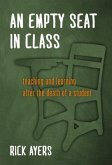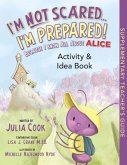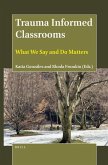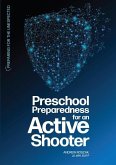Laura J Colker, Sarah Erdman, Elizabeth C Winter
Trauma and Young Children
Teaching Strategies to Support and Empower
Laura J Colker, Sarah Erdman, Elizabeth C Winter
Trauma and Young Children
Teaching Strategies to Support and Empower
- Broschiertes Buch
- Merkliste
- Auf die Merkliste
- Bewerten Bewerten
- Teilen
- Produkt teilen
- Produkterinnerung
- Produkterinnerung
Educators need access to accurate and useful guidance on helping children and families who have been exposed to trauma and Adverse Childhood Experiences (ACEs) . Learn the basics of what trauma is, what the effects can look like, and specific types of trauma that may be experienced as well as targeted suggestions for creating trauma-informed classrooms and practices that support children and families. This book brings together how educators can incorporate the community into trauma-aware practices, acknowledges and addresses the needs of educators, and offers solutions for caring for themselves as well as the populations they serve.…mehr
Andere Kunden interessierten sich auch für
![Recognize, Respond, Report Recognize, Respond, Report]() Lori ErnspergerRecognize, Respond, Report30,99 €
Lori ErnspergerRecognize, Respond, Report30,99 €![Toolkit for Adapting Cognitive Behavioral Intervention for Trauma in Schools (CBITS) or Supporting Students Exposed to Trauma (SSET) for Implementation with Youth in Foster Care Toolkit for Adapting Cognitive Behavioral Intervention for Trauma in Schools (CBITS) or Supporting Students Exposed to Trauma (SSET) for Implementation with Youth in Foster Care]() Dana SchultzToolkit for Adapting Cognitive Behavioral Intervention for Trauma in Schools (CBITS) or Supporting Students Exposed to Trauma (SSET) for Implementation with Youth in Foster Care23,99 €
Dana SchultzToolkit for Adapting Cognitive Behavioral Intervention for Trauma in Schools (CBITS) or Supporting Students Exposed to Trauma (SSET) for Implementation with Youth in Foster Care23,99 €![An Empty Seat in Class An Empty Seat in Class]() Rick AyersAn Empty Seat in Class37,99 €
Rick AyersAn Empty Seat in Class37,99 €![I'm Not Scared...I'm Prepared! Activity and Idea Book I'm Not Scared...I'm Prepared! Activity and Idea Book]() Julia CookI'm Not Scared...I'm Prepared! Activity and Idea Book11,99 €
Julia CookI'm Not Scared...I'm Prepared! Activity and Idea Book11,99 €![Adult Interactive Style Intervention and Participatory Research Designs in Autism Adult Interactive Style Intervention and Participatory Research Designs in Autism]() Lila KossyvakiAdult Interactive Style Intervention and Participatory Research Designs in Autism68,99 €
Lila KossyvakiAdult Interactive Style Intervention and Participatory Research Designs in Autism68,99 €![Trauma Informed Classrooms Trauma Informed Classrooms]() Trauma Informed Classrooms64,99 €
Trauma Informed Classrooms64,99 €![Preschool Preparedness for an Active Shooter Preschool Preparedness for an Active Shooter]() Andrew RoszakPreschool Preparedness for an Active Shooter18,99 €
Andrew RoszakPreschool Preparedness for an Active Shooter18,99 €-
-
-
Educators need access to accurate and useful guidance on helping children and families who have been exposed to trauma and Adverse Childhood Experiences (ACEs) . Learn the basics of what trauma is, what the effects can look like, and specific types of trauma that may be experienced as well as targeted suggestions for creating trauma-informed classrooms and practices that support children and families. This book brings together how educators can incorporate the community into trauma-aware practices, acknowledges and addresses the needs of educators, and offers solutions for caring for themselves as well as the populations they serve.
Hinweis: Dieser Artikel kann nur an eine deutsche Lieferadresse ausgeliefert werden.
Hinweis: Dieser Artikel kann nur an eine deutsche Lieferadresse ausgeliefert werden.
Produktdetails
- Produktdetails
- Verlag: National Association for the Education of Young Children
- Seitenzahl: 144
- Erscheinungstermin: 15. September 2020
- Englisch
- Abmessung: 274mm x 213mm x 10mm
- Gewicht: 476g
- ISBN-13: 9781938113673
- ISBN-10: 1938113675
- Artikelnr.: 57167832
- Herstellerkennzeichnung
- Libri GmbH
- Europaallee 1
- 36244 Bad Hersfeld
- 06621 890
- Verlag: National Association for the Education of Young Children
- Seitenzahl: 144
- Erscheinungstermin: 15. September 2020
- Englisch
- Abmessung: 274mm x 213mm x 10mm
- Gewicht: 476g
- ISBN-13: 9781938113673
- ISBN-10: 1938113675
- Artikelnr.: 57167832
- Herstellerkennzeichnung
- Libri GmbH
- Europaallee 1
- 36244 Bad Hersfeld
- 06621 890
Sarah Erdman is an experienced early childhood educator and museum professional in Northern Virginia. Her research and professional practice explore how museums and educators can connect to make meaningful experiences for young children. Sarah teaches at FB Meekins Cooperative Preschool and serves on the board of the Northern Virginia Association for the Education of Young Children. She brings her experience as a mother and educator to all the work she does and is a committed advocate for educators and young children. She is a graduate of the University of Maine and earned a MAT in Museum Education from The George Washington University and an AAS in Early Childhood Development from the Northern Virginia Community College. Sarah founded Cabinet of Curiosities LLC and has served as the early childhood consultant for institutions such as the National Museum of American History, the LBJ Presidential Library and Museum and The Phillips Collection. She is also a skilled trainer working with both early childhood educators and museum professionals. Sarah was the creator and editor of The Care and Keeping of Museum Professionals, a collection of reflective essays on the state of the museum field. She has also published extensively in NAEYC's Young Children and Teaching Young Children as well as contributing to publications of the American Alliance of Museums, the National Museum of American History and the National Science Teachers Association. Laura J. Colker , EdD, is the President of L.J. Colker & Associates in Washington, DC. She is an author, lecturer, and trainer in early childhood education with 40 years of experience. She has written or co-authored over 150 publications and contributed to the development of 45 educational videos and PBS programs. Dr. Colker is most widely known as a co-author of The Creative Curriculum for Preschool, now in its 6th edition. She is also a co-author of The Creative Curriculum for Family Child Care and the first edition of The Creative Curriculum for Infants, Toddlers, and Twos. Her two most recent books are High-Quality Early Childhood Programs: The What, Why, and How and Making Lemonade: Teaching Young Children How to Think Optimistically. Both books are co-authored with Derry Koralek. For nine years, Colker was a contributing editor to Teaching Young Children, NAEYC's journal for preschool teachers. She has also been a consultant to Reading Is Fundamental (RIF), The Council for Professional Development, Zero to Three, WestEd, the Head Start Bureau, NACCRA (now Child Care Aware), the University of Minnesota, Sonoma State University, the Los Angeles Unified School District, all of the military services' child development programs, the Department of Defense Education Activity, and numerous other education-related institutions and organizations. Elizabeth C. Winter, MD, is a board-certified psychiatrist living in Baltimore, MD. She is a Senior Physician with the Department of Veterans Affairs, Office of the Inspector General and a faculty member of the Johns Hopkins Hospital Department of Psychiatry and Behavioral Sciences. Dr. Winter began her career in private practice, providing medication management and psychotherapy. While in private practice, she became the co-director of the Johns Hopkins Anxiety Disorders Clinic, a tertiary consultation service providing in depth evaluations, formulations, and treatment recommendations. After leaving private practice, Dr. Winter was the medical director of a dual diagnosis facility in Maryland before joining the faculty of University of Maryland as an inpatient hospitalist. She joined the VA OIG in 2018. Dr. Winter has worked in medical student and resident education for over 10 years at Johns Hopkins and the University of Maryland. In addition to individual mentoring, clerkship lectures, and seminars, Dr. Winter developed a 6-month long curriculum on the diagnosis and management of anxiety disorders for third year psychiatry residents in the subspecialty clinic rotation. She has published extensively in academic journals, book chapters, and articles for the general public on issues related to psychiatry.
Preface Chapter 1: Introduction Why It Is Important to Understand Trauma
Prevalence of Trauma Trauma-Informed Care Early Childhood Educators Matter
A Path Forward Chapter 2: Types of Trauma Experienced by Young Children
What Is Trauma? Key Concepts Related to Trauma Adverse Childhood
Experiences Causes of Trauma Category 1: Household and Family Category 2:
Loss Category 3: Family Separations Category 4: Violence and Disasters
Post-Traumatic Stress Disorder Role of Racism in Trauma and Child
Well-Being The Influence of Other Factors on Children's Experiences of
Trauma Responses to Trauma Are Individual A Path Forward Chapter 3: How
Trauma Impacts Young Children's Brains and Their Ability to Learn Brain
Circuits and Connections Experience and Brain Connections Responding to
Stress The Impact of Trauma on Development and Learning What Toxic Stress
Looks Like in Early Childhood Programs A Path Forward Chapter 4: Guiding
Principles for Teaching Children with Trauma Principle 1: Recognize that
All Children Will Benefit from a Trauma-Informed Approach Principle 2: Use
a Strengths-Based Approach to Teaching Principle 3: Recognize, Appreciate,
and Address Differing Influences on Children's Experiences with Trauma
Principle 4: Embrace Resilience as a Goal for Every Child Principle 5: Help
Children Learn to Regulate Their Emotions Principle 6: Use Positive
Guidance When Dealing with Children's Challenging Behaviors Principle 7: Be
a Role Model to Children on How to Act and Approach Learning Principle 8:
Help Children Turn Negative Thinking Around Principle 9: Enrich the
Children's Lives with Art, Music, and Dance Principle 10: Look Beyond
Children's Traumas and Celebrate the Joys in Life Principle 11: Remember
that You Don't Have to Have All the Answers A Path Forward Chapter 5:
Establishing a Safe and Inviting Environment for Learning Design a Physical
Environment that Supports Children's Emotional, Social, Physical, and
Learning Needs Provide Materials that Support Learning and Healing Bring
Structure to the Environment Through the Daily Schedule Tips for the
Physical Environment A Path Forward Chapter 6: Connecting with Children How
to Foster Relationships When Children Have Experienced Trauma Help Children
Form Strong Friendships with Their Peers Mindfulness As a Tool For Building
Relationships and Other Needed Skills Tips for Interacting with Children A
Path Forward Chapter 7: The Healing Power of Play Benefits of Play When
There Is Trauma A Right to Play? The Impact of Trauma on Play Using Play to
Address Trauma's Negative Effects Using Playful Learning with Children Who
Are Distressed When Violence Is a Part of Play Tips for Using Children's
Play as a Healing Agent A Path Forward Chapter 8: Partnering with Families
What Is a Family? What Is Engagement? Special Considerations in Working
with Families of Children Who Have Experienced Trauma Connecting with
Families to Benefit Children A Path Forward Chapter 9: Trauma-Informed Care
in Schools and Communities TIC and the School Community The Four Rs
Framework and Six Principles of TIC What TIC Looks Like in Action Working
with Your Administrator Advocacy A Path Forward Chapter 10: Caring for
Yourself Your Own Compounding Stress Defining Teaching-Related Stress Using
Self-Care to Overcome Secondary Trauma A Path Forward Appendix One:
Resources for Educators Appendix Two: Picture Books About Trauma Appendix
Three: Handouts for Families References Index Acknowledgments About the
Authors
Prevalence of Trauma Trauma-Informed Care Early Childhood Educators Matter
A Path Forward Chapter 2: Types of Trauma Experienced by Young Children
What Is Trauma? Key Concepts Related to Trauma Adverse Childhood
Experiences Causes of Trauma Category 1: Household and Family Category 2:
Loss Category 3: Family Separations Category 4: Violence and Disasters
Post-Traumatic Stress Disorder Role of Racism in Trauma and Child
Well-Being The Influence of Other Factors on Children's Experiences of
Trauma Responses to Trauma Are Individual A Path Forward Chapter 3: How
Trauma Impacts Young Children's Brains and Their Ability to Learn Brain
Circuits and Connections Experience and Brain Connections Responding to
Stress The Impact of Trauma on Development and Learning What Toxic Stress
Looks Like in Early Childhood Programs A Path Forward Chapter 4: Guiding
Principles for Teaching Children with Trauma Principle 1: Recognize that
All Children Will Benefit from a Trauma-Informed Approach Principle 2: Use
a Strengths-Based Approach to Teaching Principle 3: Recognize, Appreciate,
and Address Differing Influences on Children's Experiences with Trauma
Principle 4: Embrace Resilience as a Goal for Every Child Principle 5: Help
Children Learn to Regulate Their Emotions Principle 6: Use Positive
Guidance When Dealing with Children's Challenging Behaviors Principle 7: Be
a Role Model to Children on How to Act and Approach Learning Principle 8:
Help Children Turn Negative Thinking Around Principle 9: Enrich the
Children's Lives with Art, Music, and Dance Principle 10: Look Beyond
Children's Traumas and Celebrate the Joys in Life Principle 11: Remember
that You Don't Have to Have All the Answers A Path Forward Chapter 5:
Establishing a Safe and Inviting Environment for Learning Design a Physical
Environment that Supports Children's Emotional, Social, Physical, and
Learning Needs Provide Materials that Support Learning and Healing Bring
Structure to the Environment Through the Daily Schedule Tips for the
Physical Environment A Path Forward Chapter 6: Connecting with Children How
to Foster Relationships When Children Have Experienced Trauma Help Children
Form Strong Friendships with Their Peers Mindfulness As a Tool For Building
Relationships and Other Needed Skills Tips for Interacting with Children A
Path Forward Chapter 7: The Healing Power of Play Benefits of Play When
There Is Trauma A Right to Play? The Impact of Trauma on Play Using Play to
Address Trauma's Negative Effects Using Playful Learning with Children Who
Are Distressed When Violence Is a Part of Play Tips for Using Children's
Play as a Healing Agent A Path Forward Chapter 8: Partnering with Families
What Is a Family? What Is Engagement? Special Considerations in Working
with Families of Children Who Have Experienced Trauma Connecting with
Families to Benefit Children A Path Forward Chapter 9: Trauma-Informed Care
in Schools and Communities TIC and the School Community The Four Rs
Framework and Six Principles of TIC What TIC Looks Like in Action Working
with Your Administrator Advocacy A Path Forward Chapter 10: Caring for
Yourself Your Own Compounding Stress Defining Teaching-Related Stress Using
Self-Care to Overcome Secondary Trauma A Path Forward Appendix One:
Resources for Educators Appendix Two: Picture Books About Trauma Appendix
Three: Handouts for Families References Index Acknowledgments About the
Authors
Preface Chapter 1: Introduction Why It Is Important to Understand Trauma
Prevalence of Trauma Trauma-Informed Care Early Childhood Educators Matter
A Path Forward Chapter 2: Types of Trauma Experienced by Young Children
What Is Trauma? Key Concepts Related to Trauma Adverse Childhood
Experiences Causes of Trauma Category 1: Household and Family Category 2:
Loss Category 3: Family Separations Category 4: Violence and Disasters
Post-Traumatic Stress Disorder Role of Racism in Trauma and Child
Well-Being The Influence of Other Factors on Children's Experiences of
Trauma Responses to Trauma Are Individual A Path Forward Chapter 3: How
Trauma Impacts Young Children's Brains and Their Ability to Learn Brain
Circuits and Connections Experience and Brain Connections Responding to
Stress The Impact of Trauma on Development and Learning What Toxic Stress
Looks Like in Early Childhood Programs A Path Forward Chapter 4: Guiding
Principles for Teaching Children with Trauma Principle 1: Recognize that
All Children Will Benefit from a Trauma-Informed Approach Principle 2: Use
a Strengths-Based Approach to Teaching Principle 3: Recognize, Appreciate,
and Address Differing Influences on Children's Experiences with Trauma
Principle 4: Embrace Resilience as a Goal for Every Child Principle 5: Help
Children Learn to Regulate Their Emotions Principle 6: Use Positive
Guidance When Dealing with Children's Challenging Behaviors Principle 7: Be
a Role Model to Children on How to Act and Approach Learning Principle 8:
Help Children Turn Negative Thinking Around Principle 9: Enrich the
Children's Lives with Art, Music, and Dance Principle 10: Look Beyond
Children's Traumas and Celebrate the Joys in Life Principle 11: Remember
that You Don't Have to Have All the Answers A Path Forward Chapter 5:
Establishing a Safe and Inviting Environment for Learning Design a Physical
Environment that Supports Children's Emotional, Social, Physical, and
Learning Needs Provide Materials that Support Learning and Healing Bring
Structure to the Environment Through the Daily Schedule Tips for the
Physical Environment A Path Forward Chapter 6: Connecting with Children How
to Foster Relationships When Children Have Experienced Trauma Help Children
Form Strong Friendships with Their Peers Mindfulness As a Tool For Building
Relationships and Other Needed Skills Tips for Interacting with Children A
Path Forward Chapter 7: The Healing Power of Play Benefits of Play When
There Is Trauma A Right to Play? The Impact of Trauma on Play Using Play to
Address Trauma's Negative Effects Using Playful Learning with Children Who
Are Distressed When Violence Is a Part of Play Tips for Using Children's
Play as a Healing Agent A Path Forward Chapter 8: Partnering with Families
What Is a Family? What Is Engagement? Special Considerations in Working
with Families of Children Who Have Experienced Trauma Connecting with
Families to Benefit Children A Path Forward Chapter 9: Trauma-Informed Care
in Schools and Communities TIC and the School Community The Four Rs
Framework and Six Principles of TIC What TIC Looks Like in Action Working
with Your Administrator Advocacy A Path Forward Chapter 10: Caring for
Yourself Your Own Compounding Stress Defining Teaching-Related Stress Using
Self-Care to Overcome Secondary Trauma A Path Forward Appendix One:
Resources for Educators Appendix Two: Picture Books About Trauma Appendix
Three: Handouts for Families References Index Acknowledgments About the
Authors
Prevalence of Trauma Trauma-Informed Care Early Childhood Educators Matter
A Path Forward Chapter 2: Types of Trauma Experienced by Young Children
What Is Trauma? Key Concepts Related to Trauma Adverse Childhood
Experiences Causes of Trauma Category 1: Household and Family Category 2:
Loss Category 3: Family Separations Category 4: Violence and Disasters
Post-Traumatic Stress Disorder Role of Racism in Trauma and Child
Well-Being The Influence of Other Factors on Children's Experiences of
Trauma Responses to Trauma Are Individual A Path Forward Chapter 3: How
Trauma Impacts Young Children's Brains and Their Ability to Learn Brain
Circuits and Connections Experience and Brain Connections Responding to
Stress The Impact of Trauma on Development and Learning What Toxic Stress
Looks Like in Early Childhood Programs A Path Forward Chapter 4: Guiding
Principles for Teaching Children with Trauma Principle 1: Recognize that
All Children Will Benefit from a Trauma-Informed Approach Principle 2: Use
a Strengths-Based Approach to Teaching Principle 3: Recognize, Appreciate,
and Address Differing Influences on Children's Experiences with Trauma
Principle 4: Embrace Resilience as a Goal for Every Child Principle 5: Help
Children Learn to Regulate Their Emotions Principle 6: Use Positive
Guidance When Dealing with Children's Challenging Behaviors Principle 7: Be
a Role Model to Children on How to Act and Approach Learning Principle 8:
Help Children Turn Negative Thinking Around Principle 9: Enrich the
Children's Lives with Art, Music, and Dance Principle 10: Look Beyond
Children's Traumas and Celebrate the Joys in Life Principle 11: Remember
that You Don't Have to Have All the Answers A Path Forward Chapter 5:
Establishing a Safe and Inviting Environment for Learning Design a Physical
Environment that Supports Children's Emotional, Social, Physical, and
Learning Needs Provide Materials that Support Learning and Healing Bring
Structure to the Environment Through the Daily Schedule Tips for the
Physical Environment A Path Forward Chapter 6: Connecting with Children How
to Foster Relationships When Children Have Experienced Trauma Help Children
Form Strong Friendships with Their Peers Mindfulness As a Tool For Building
Relationships and Other Needed Skills Tips for Interacting with Children A
Path Forward Chapter 7: The Healing Power of Play Benefits of Play When
There Is Trauma A Right to Play? The Impact of Trauma on Play Using Play to
Address Trauma's Negative Effects Using Playful Learning with Children Who
Are Distressed When Violence Is a Part of Play Tips for Using Children's
Play as a Healing Agent A Path Forward Chapter 8: Partnering with Families
What Is a Family? What Is Engagement? Special Considerations in Working
with Families of Children Who Have Experienced Trauma Connecting with
Families to Benefit Children A Path Forward Chapter 9: Trauma-Informed Care
in Schools and Communities TIC and the School Community The Four Rs
Framework and Six Principles of TIC What TIC Looks Like in Action Working
with Your Administrator Advocacy A Path Forward Chapter 10: Caring for
Yourself Your Own Compounding Stress Defining Teaching-Related Stress Using
Self-Care to Overcome Secondary Trauma A Path Forward Appendix One:
Resources for Educators Appendix Two: Picture Books About Trauma Appendix
Three: Handouts for Families References Index Acknowledgments About the
Authors

